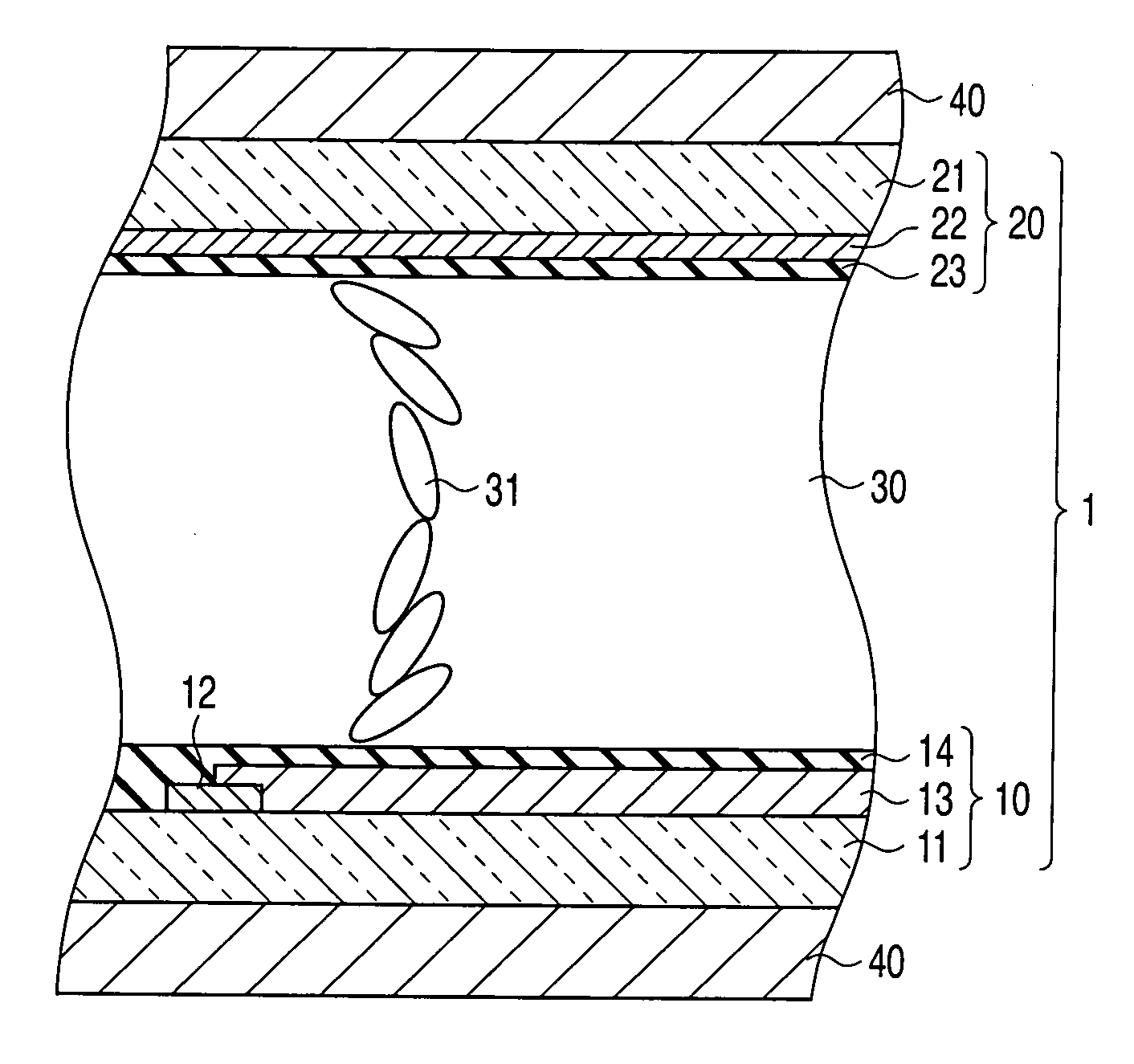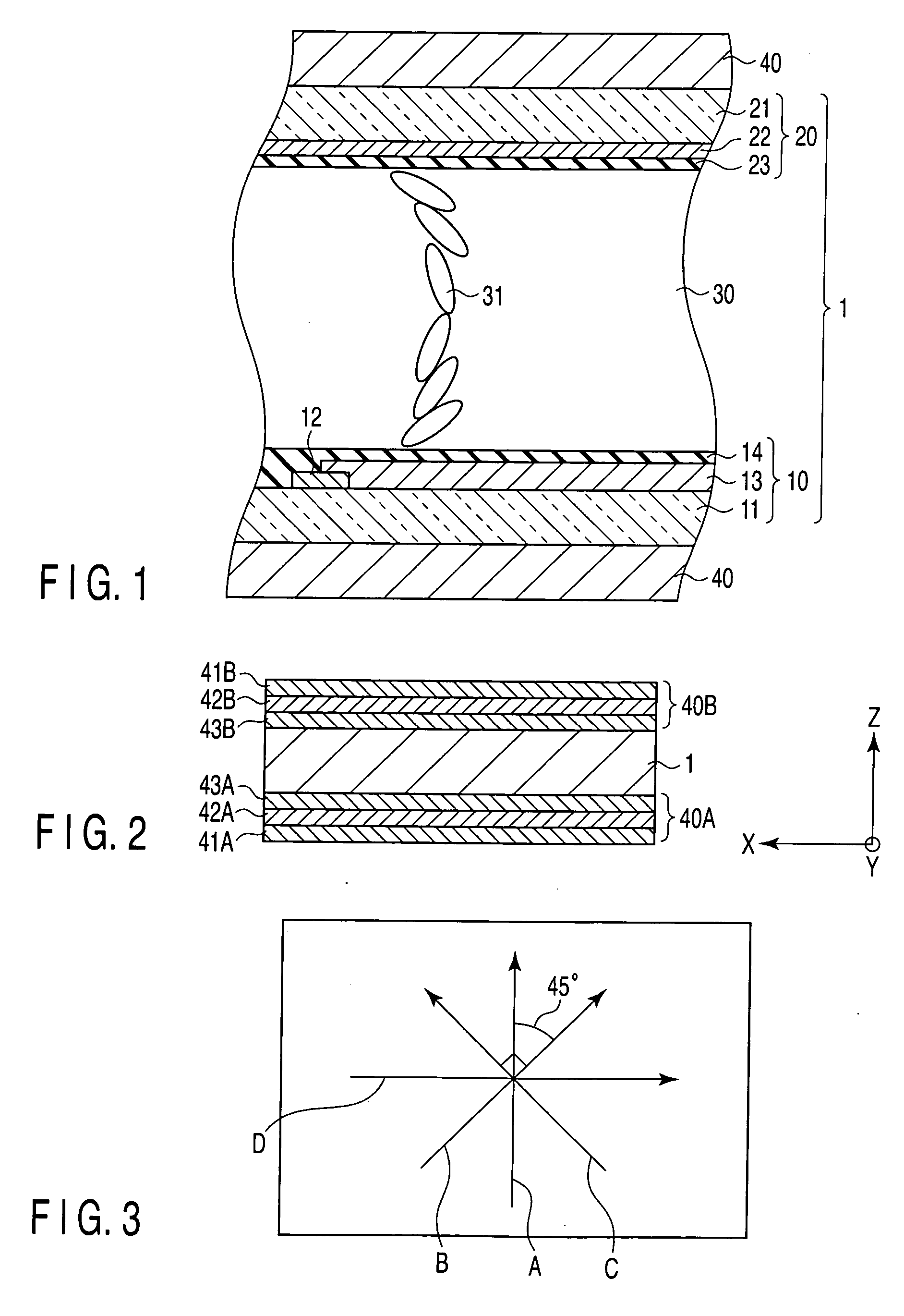Liquid crystal display device
- Summary
- Abstract
- Description
- Claims
- Application Information
AI Technical Summary
Benefits of technology
Problems solved by technology
Method used
Image
Examples
first embodiment
[0059] As is shown in FIG. 7, in an OCB liquid crystal display device according to a first embodiment, optical compensation elements 40A and 40B are provided on the array substrate (10)-side outer surface of the liquid crystal panel 1 and on the opposed substrate (20)-side outer surface of the liquid crystal panel 1.
[0060] The optical compensation element 40A on the array substrate 10 side includes a polarizer plate 41A, a phase plate 42A having retardation in its thickness direction, a first phase plate 43A having retardation in its front-plane direction, and a second phase plate 44A having retardation in its front-plane direction. Similarly, the optical compensation element 40B on the opposed substrate 20 side includes a polarizer plate 41B, a phase plate 42B having retardation in its thickness direction, a first phase plate 43B having retardation in its front-plane direction, and a second phase plate 44B having retardation in its front-plane direction. The transmission-axis dire...
second embodiment
[0073] As is shown in FIG. 9, like the first embodiment, in an OCB liquid crystal display device according to a second embodiment, optical compensation elements 40A and 40B are provided on the array substrate (10)-side outer surface of the liquid crystal panel 1 and on the opposed substrate (20)-side outer surface of the liquid crystal panel 1. The structural components common to those in the first embodiment are denoted by like reference numerals, and a detailed description thereof is omitted.
[0074] The optical compensation element 40A on the array substrate 10 side includes a polarizer plate 41A, a phase plate 42A having retardation in its thickness direction, a first phase plate 43A having retardation in its front-plane direction, and a second phase plate 44A having retardation in its front-plane direction. On the other hand, the optical compensation element 40B on the opposed substrate 20 side includes a polarizer plate 41B, a phase plate 42B having retardation in its thickness...
third embodiment
[0079] As is shown in FIG. 10, like the first embodiment, in an OCB liquid crystal display device according to a third embodiment, optical compensation elements 40A and 40B are provided on the array substrate (10)-side outer surface of the liquid crystal panel 1 and on the opposed substrate (20)-side outer surface of the liquid crystal panel 1. The structural components common to those in the first embodiment are denoted by like reference numerals, and a detailed description thereof is omitted.
[0080] The optical compensation element 40A on the array substrate 10 side includes a polarizer plate 41A, a phase plate 42A having retardation in its thickness direction, and a first phase plate 43A having retardation in its front-plane direction. On the other hand, the optical compensation element 40B on the opposed substrate 20 side includes a polarizer plate 41B, a phase plate 42B having retardation in its thickness direction, and a second phase plate 44B having retardation in its front-p...
PUM
 Login to View More
Login to View More Abstract
Description
Claims
Application Information
 Login to View More
Login to View More - R&D
- Intellectual Property
- Life Sciences
- Materials
- Tech Scout
- Unparalleled Data Quality
- Higher Quality Content
- 60% Fewer Hallucinations
Browse by: Latest US Patents, China's latest patents, Technical Efficacy Thesaurus, Application Domain, Technology Topic, Popular Technical Reports.
© 2025 PatSnap. All rights reserved.Legal|Privacy policy|Modern Slavery Act Transparency Statement|Sitemap|About US| Contact US: help@patsnap.com



